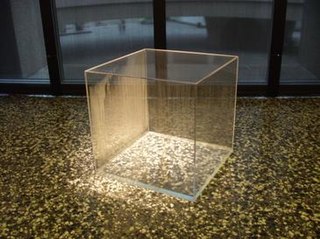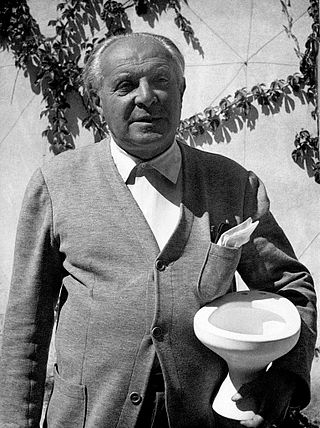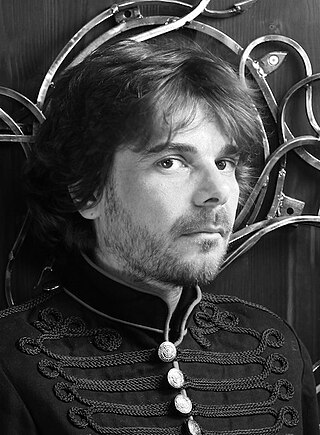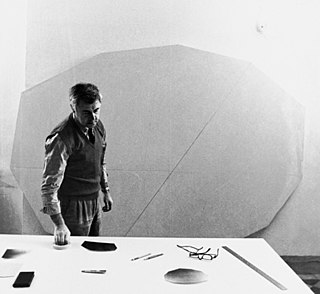
Ugo Nespolo is an Italian artist,painter,sculptor,filmmaker and writer. He lives and works in Turin.

Cagliari is an Italian municipality and the capital and largest city of the island of Sardinia,an autonomous region of Italy. It has about 155,000 inhabitants,while its metropolitan city has about 420,000 inhabitants. According to Eurostat,the population of the functional urban area,the commuting zone of Cagliari,rises to 476,975. Cagliari is the 26th largest city in Italy and the largest city on the island of Sardinia.

Generative art is post-conceptual art that has been created with the use of an autonomous system. An autonomous system in this context is generally one that is non-human and can independently determine features of an artwork that would otherwise require decisions made directly by the artist. In some cases the human creator may claim that the generative system represents their own artistic idea,and in others that the system takes on the role of the creator.

Leonardo Sinisgalli (1908–1981) was an Italian poet and art critic active from the 1930s to the 1970s.

Giovanni "Gio" Ponti was an Italian architect,industrial designer,furniture designer,artist,teacher,writer and publisher.

Achille Castiglioni was an Italian architect and designer of furniture,lighting,radiograms and other objects. As a professor of design,he advised his students "If you are not curious,forget it. If you are not interested in others,what they do and how they act,then being a designer is not the right job for you."
Marco Piva,Italian architect,interior designer and product designer,born on February 15,1952,in Milan.

Stefano Boeri is an Italian architect and urban planner,and a founding partner of Stefano Boeri Architetti. Among his most known projects are the Vertical Forest in Milan,the Villa Méditerranée in Marseille,and the House of the Sea of La Maddalena. He is the professor of urban planning at the Polytechnic University of Milan.
Digital morphogenesis is a type of generative art in which complex shape development,or morphogenesis,is enabled by computation. This concept is applicable in many areas of design,art,architecture,and modeling. The concept was originally developed in the field of biology,later in geology,geomorphology,and architecture.

Generative design is an iterative design process that uses software to generate outputs that fulfill a set of constraints iteratively adjusted by a designer. Whether a human,test program,or artificial intelligence,the designer algorithmically or manually refines the feasible region of the program's inputs and outputs with each iteration to fulfill evolving design requirements. By employing computing power to evaluate more design permutations than a human alone is capable of,the process is capable of producing an optimal design that mimics nature's evolutionary approach to design through genetic variation and selection. The output can be images,sounds,architectural models,animation,and much more. It is,therefore,a fast method of exploring design possibilities that is used in various design fields such as art,architecture,communication design,and product design.

Duilio Forte is a Swedish-Italian artist and architect. He works primarily with wood and iron,creating large sculptures and unique exterior sculptural saunas. He teaches at the Nuova Accademia Belle Arti di Milano and other institutions in Italy.

Francesco Ciusa was an Italian sculptor.
Vittoria Chierici is an Italian artist.
Giuseppe Veneziano is an Italian painter and one of the leading figures of Italian art groups "New Pop" and "Italian Newbrow".

Luciano Caramel was an Italian art critic,curator,and art historian. In the 1980s he was Deputy Director of the Accademia di Belle Arti di Brera in Milan. He taught contemporary art at the UniversitàCattolica del Sacro Cuore in Milan and at Accademia Albertina in Turin. He was an expert on the work of Medardo Rosso. His publications include Arte in Italia 1945-1960,a university textbook.

Enrico Crispolti was an Italian art critic,curator and art historian. From 1984 to 2005,he was professor of history of contemporary art at the Universitàdegli Studi di Siena,and director of the school of specialisation in art history. He previously taught at the Accademia di Belle Arti in Rome (1966–1973) and at the Universitàdegli Studi di Salerno (1973–1984). He was author of the catalogues raisonnés of the works of Enrico Baj,Lucio Fontana and Renato Guttuso. He died in Rome on 8 December 2018.
Walter Noetico is an Italian painter,sculptor,and writer. He is the founder of two art movements:Indimensionalism and Neoilluminism. He is also the inventor of new artistic techniques and of the new Alphabet,Neoilluminist Alphabet,in which every letter has a symbol of a woman and a man.

Rodolfo Aricò was an Italian painter and theatre set designer.
Salvatore Pica was an Italian art and design entrepreneur. He was one of the first to promote design and contemporary art culture in post-war southern Italy.
Paolo Schiavocampo was an Italian painter and sculptor. He received most of his success from his collaborations with Fiumara d'arte in Messina.












